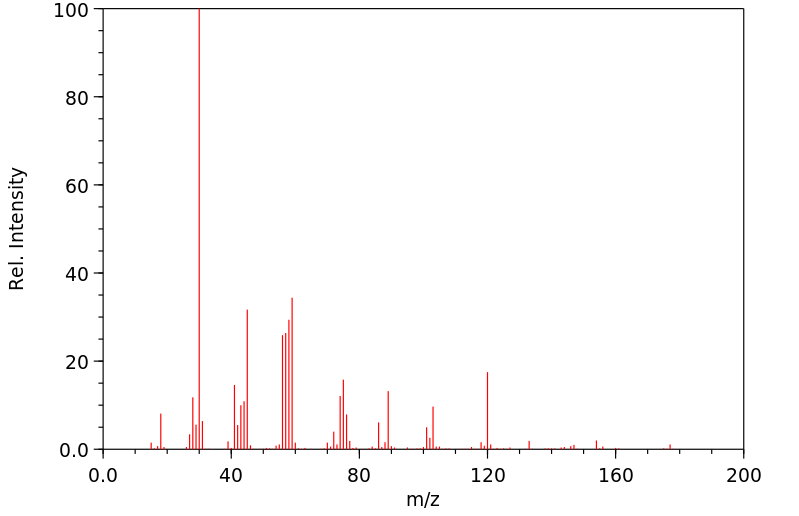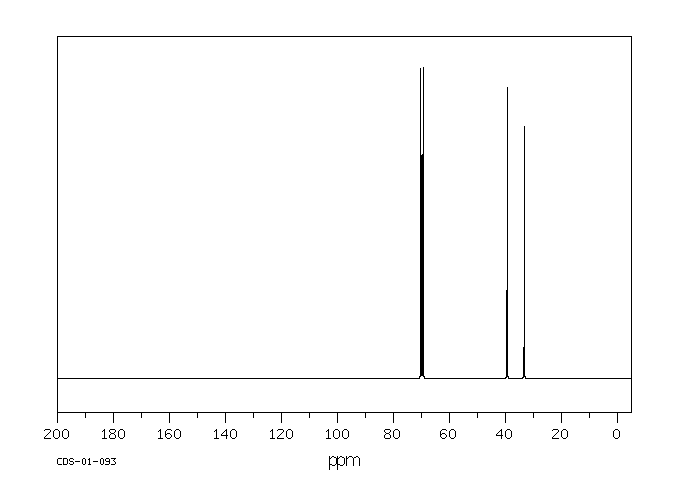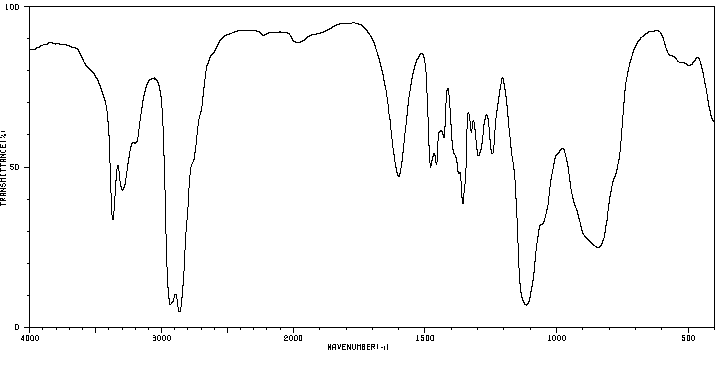乙二醇双(3-胺丙基)醚 | 2997-01-5
中文名称
乙二醇双(3-胺丙基)醚
中文别名
3,3-(乙烷-1,2-二yl双(氧基))双(丙烷-1-胺);乙二醇二(3-氨丙基)醚;乙二醇双(3-氨丙基)醚
英文名称
1,2-bis(3-aminopropoxy)ethane
英文别名
ethylene glycol bis(3-aminopropyl) ether;3,3’-(ethylenedioxy)bis(propylamine);1-Propanamine, 3,3'-[1,2-ethanediylbis(oxy)]bis-;3-[2-(3-aminopropoxy)ethoxy]propan-1-amine
CAS
2997-01-5
化学式
C8H20N2O2
mdl
MFCD00059938
分子量
176.259
InChiKey
POTQBGGWSWSMCX-UHFFFAOYSA-N
BEILSTEIN
——
EINECS
——
-
物化性质
-
计算性质
-
ADMET
-
安全信息
-
SDS
-
制备方法与用途
-
上下游信息
-
文献信息
-
表征谱图
-
同类化合物
-
相关功能分类
-
相关结构分类
物化性质
-
沸点:127-130 °C (7 mmHg)
-
密度:0.9837
-
LogP:-1.24 at 21.6℃
-
稳定性/保质期:
遵照规定使用和储存,则不会发生分解。
计算性质
-
辛醇/水分配系数(LogP):-1.2
-
重原子数:12
-
可旋转键数:9
-
环数:0.0
-
sp3杂化的碳原子比例:1.0
-
拓扑面积:70.5
-
氢给体数:2
-
氢受体数:4
安全信息
-
危险等级:8
-
危险类别码:R34,R21
-
海关编码:2922199090
-
储存条件:应存放在阴凉干燥处。
SDS
| Name: | 1 10-Diamino-4 7-dioxadecane Material Safety Data Sheet |
| Synonym: | |
| CAS: | 2997-01-5 |
Synonym:
Section 2 - COMPOSITION, INFORMATION ON INGREDIENTS
| CAS# | Chemical Name | content | EINECS# |
| 2997-01-5 | 1,10-Diamino-4,7-dioxadecane | 221-067-4 |
Risk Phrases: 21 34
Section 3 - HAZARDS IDENTIFICATION
EMERGENCY OVERVIEW
Harmful in contact with skin. Causes burns.
Potential Health Effects
Eye:
Causes eye burns.
Skin:
Harmful if absorbed through the skin. Causes skin burns.
Ingestion:
Causes gastrointestinal tract burns.
Inhalation:
Causes chemical burns to the respiratory tract.
Chronic:
Not available.
Section 4 - FIRST AID MEASURES
Eyes: Immediately flush eyes with plenty of water for at least 15 minutes, occasionally lifting the upper and lower eyelids. Get medical aid immediately.
Skin:
Get medical aid immediately. Immediately flush skin with plenty of water for at least 15 minutes while removing contaminated clothing and shoes.
Ingestion:
Do not induce vomiting. Get medical aid immediately.
Inhalation:
Get medical aid immediately. Remove from exposure and move to fresh air immediately. If not breathing, give artificial respiration. If breathing is difficult, give oxygen.
Notes to Physician:
Treat symptomatically and supportively.
Section 5 - FIRE FIGHTING MEASURES
General Information:
As in any fire, wear a self-contained breathing apparatus in pressure-demand, MSHA/NIOSH (approved or equivalent), and full protective gear.
Extinguishing Media:
Use foam, dry chemical, or carbon dioxide.
Section 6 - ACCIDENTAL RELEASE MEASURES
General Information: Use proper personal protective equipment as indicated in Section 8.
Spills/Leaks:
Absorb spill with inert material (e.g. vermiculite, sand or earth), then place in suitable container.
Section 7 - HANDLING and STORAGE
Handling:
Do not breathe dust, vapor, mist, or gas. Do not get in eyes, on skin, or on clothing. Use only in a chemical fume hood.
Storage:
Store in a cool, dry place. Store in a tightly closed container.
Corrosives area.
Section 8 - EXPOSURE CONTROLS, PERSONAL PROTECTION
Engineering Controls:
Facilities storing or utilizing this material should be equipped with an eyewash facility and a safety shower. Use adequate ventilation to keep airborne concentrations low.
Exposure Limits CAS# 2997-01-5: Personal Protective Equipment Eyes: Not available.
Skin:
Wear appropriate protective gloves to prevent skin exposure.
Clothing:
Wear appropriate protective clothing to prevent skin exposure.
Respirators:
Follow the OSHA respirator regulations found in 29 CFR 1910.134 or European Standard EN 149. Use a NIOSH/MSHA or European Standard EN 149 approved respirator if exposure limits are exceeded or if irritation or other symptoms are experienced.
Section 9 - PHYSICAL AND CHEMICAL PROPERTIES
Physical State: Liquid
Color: yellow
Odor: Not available.
pH: Not available.
Vapor Pressure: Not available.
Viscosity: Not available.
Boiling Point: 127 - 130 deg C @7mmHg
Freezing/Melting Point: Not available.
Autoignition Temperature: Not available.
Flash Point: Not available.
Explosion Limits, lower: Not available.
Explosion Limits, upper: Not available.
Decomposition Temperature:
Solubility in water:
Specific Gravity/Density: 0.984
Molecular Formula: C8H20N2O2
Molecular Weight: 176.26
Section 10 - STABILITY AND REACTIVITY
Chemical Stability:
Not available.
Conditions to Avoid:
Incompatible materials.
Incompatibilities with Other Materials:
Strong oxidizing agents, strong acids.
Hazardous Decomposition Products:
Nitrogen oxides, carbon monoxide, carbon dioxide.
Hazardous Polymerization: Has not been reported
Section 11 - TOXICOLOGICAL INFORMATION
RTECS#:
CAS# 2997-01-5: UI2800000 LD50/LC50:
CAS# 2997-01-5: Oral, rat: LD50 = 2830 uL/kg; Skin, rabbit: LD50 = 1250 uL/kg.
Carcinogenicity:
1,10-Diamino-4,7-dioxadecane - Not listed by ACGIH, IARC, or NTP.
Other:
See actual entry in RTECS for complete information.
Section 12 - ECOLOGICAL INFORMATION
Section 13 - DISPOSAL CONSIDERATIONS
Dispose of in a manner consistent with federal, state, and local regulations.
Section 14 - TRANSPORT INFORMATION
IATA
Shipping Name: AMINES, LIQUID, CORROSIVE, N.O.S.*
Hazard Class: 8
UN Number: 2735
Packing Group: III
IMO
Shipping Name: AMINES, LIQUID, CORROSIVE, N.O.S.
Hazard Class: 8
UN Number: 2735
Packing Group: III
RID/ADR
Shipping Name: AMINES, LIQUID, CORROSIVE, N.O.S.
Hazard Class: 8
UN Number: 2735
Packing group: III
Section 15 - REGULATORY INFORMATION
European/International Regulations
European Labeling in Accordance with EC Directives
Hazard Symbols: C
Risk Phrases:
R 21 Harmful in contact with skin.
R 34 Causes burns.
Safety Phrases:
S 26 In case of contact with eyes, rinse immediately
with plenty of water and seek medical advice.
S 36/37/39 Wear suitable protective clothing, gloves
and eye/face protection.
S 45 In case of accident or if you feel unwell, seek
medical advice immediately (show the label where
possible).
WGK (Water Danger/Protection)
CAS# 2997-01-5: No information available.
Canada
CAS# 2997-01-5 is listed on Canada's NDSL List.
CAS# 2997-01-5 is not listed on Canada's Ingredient Disclosure List.
US FEDERAL
TSCA
CAS# 2997-01-5 is listed on the TSCA inventory.
SECTION 16 - ADDITIONAL INFORMATION
N/A
制备方法与用途
自组装材料与接触印刷材料
上下游信息
-
上游原料
中文名称 英文名称 CAS号 化学式 分子量 1,2-二(2-氰乙氧基)乙烷 1,2-bis-(2-cyanoethoxy)ethane 3386-87-6 C8H12N2O2 168.195 -
下游产品
中文名称 英文名称 CAS号 化学式 分子量 氨基丙基醚 bis(3-aminopropyl)ether 2157-24-6 C6H16N2O 132.206
反应信息
-
作为反应物:描述:参考文献:名称:环磷腈中螺与安萨困境的答案摘要:摘要 在合适的条件下,二氧二胺对 N3P3Cl6 的氨解产生了两种环磷腈大分子 ANSA 和大分子 SPIRO 物种,它们将作为大环配体用于进一步的应用。DOI:10.1016/0022-2860(89)80155-3
-
作为产物:描述:参考文献:名称:DE734475摘要:公开号:
文献信息
-
Synthesis and Structure−Activity Relationships of Phenylenebis(methylene)- Linked Bis-azamacrocycles That Inhibit HIV-1 and HIV-2 Replication by Antagonism of the Chemokine Receptor CXCR4作者:Gary J. Bridger、Renato T. Skerlj、Sreenivasan Padmanabhan、Stephen A. Martellucci、Geoffrey W. Henson、Sofie Struyf、Myriam Witvrouw、Dominique Schols、Erik De ClercqDOI:10.1021/jm990211i日期:1999.9.1antiviral potency or increased cytotoxicity to MT-4 cells. Finally, we synthesized a series of analogues in which the ring size of the bis-pyridyl macrocycles was varied between 12 and 16 members per ring including the py[iso-14]aneN(4) ring system, an isomer of the py[14]aneN(4) macrocycle. The p-phenylenebis(methylene)-linked dimer of the py[iso-14]aneN(4) (AMD3329) displayed the highest antiviral activityBis-tetraazAMacrocycles,例如bicyclAM AMD3100,是一类有效的和选择性的抗HIV-1和HIV-2药剂,它们通过结合趋化因子受体CXCR4(X4病毒进入的共同受体)而抑制病毒复制。为了优化双氮杂双环类化合物的抗HIV-1和HIV-2活性,合成了一系列类似物,这些类似物包含中性杂原子(氧,硫)或杂芳香族(pK(a)比仲胺低)替代AMD3100的氨基。将一个或多个杂原子(例如氧或硫)引入对亚苯基双(亚甲基)连接的二聚体的大环中(生成N(3)X或N(2)X(2)双大环),得到类似物大大降低了抗HIV-1(III(B))和抗HIV-2(ROD)的效力。此外,双硫类似物对MT-4细胞也有明显的细胞毒性。然而,具有掺入大环骨架中的单个吡啶基团的双-四氮杂大环化合物显示出与其饱和的脂族对应物相当的抗HIV-1和HIV-2效能。py [14] aneN(4)大环的对亚苯基
-
A MedChem toolbox for cereblon-directed PROTACs作者:Christian Steinebach、Izidor Sosič、Stefanie Lindner、Aleša Bricelj、Franziska Kohl、Yuen Lam Dora Ng、Marius Monschke、Karl G. Wagner、Jan Krönke、Michael GütschowDOI:10.1039/c9md00185a日期:——
A modular chemistry toolbox was developed for cereblon-directed PROTACs.
为 cereblon 定向 PROTACs 开发了一个模块化化学工具箱。
-
[EN] DIMERIC IAP INHIBITORS<br/>[FR] INHIBITEURS IAP DIMÉRIQUES申请人:NOVARTIS AG公开号:WO2012080271A1公开(公告)日:2012-06-21The present invention provides compounds of formula M-L-M' (where M and M' are each independently a monomeric moiety of Formula (I) and L is a linker). The dimeric compounds have been found to be effective in promoting apoptosis in rapidly dividing cells. (I)本发明提供了公式M-L-M'的化合物(其中M和M'分别独立地是公式(I)的单体基团,L是连接基团)。已发现二聚化合物在促进快速分裂细胞凋亡方面具有有效性。(I)
-
Inhibitors of checkpoint kinases (Wee1 and Chk1)申请人:Booth John Richard公开号:US20050250836A1公开(公告)日:2005-11-10This invention relates to substituted indacene molecules that specifically inhibit one or both of the checkpoint kinases Wee1 and Chk1 and are useful in the treatment of proliferative disorders.这项发明涉及替代的吲哚烯分子,特异性地抑制检查点激酶Wee1和Chk1中的一个或两个,并在治疗增殖性疾病中有用。
-
The Delicate Balance of Preorganisation and Adaptability in Multiply Bonded Host-Guest Complexes作者:Larissa K. S. von Krbek、Andreas J. Achazi、Stefan Schoder、Marius Gaedke、Tobias Biberger、Beate Paulus、Christoph A. SchalleyDOI:10.1002/chem.201605092日期:2017.2.24affinity in multiply bonded supramolecular complexes as they help reduce the entropic penalty of the binding event. This comes at the price that such rigid complexes are sensitive to small geometric mismatches. In marked contrast, nature uses more flexible building blocks. Thus, one might consider putting the rigidity/high‐affinity notion to the test. Multivalent crown/ammonium complexes are ideal for this刚性和预组织被认为是多重键合超分子复合物中高亲和力所必需的,因为它们有助于减少结合事件的熵损失。这是以这样的刚性复合物对小的几何失配敏感的代价为代价的。与此形成鲜明对比的是,自然界使用了更为灵活的构建基块。因此,可以考虑将“刚度/高亲和力”概念用于测试。多价冠/铵络合物对于此目的是理想的,因为单价相互作用是众所周知的。因此,已经分析了一系列具有不同间隔长度和刚性的二价络合物,以使螯合协同性和间隔物性质相互关联。与完全匹配的间隔物相比,间隔物过长会降低螯合剂的协同作用。但是,与预期相反,灵活的客人与螯合剂的结合力明显超过了刚性结构。柔性垫片可适应较小的几何形状的主客体不匹配。间隔物之间的相互作用有助于克服结合过程中构象固定的熵损失,并且在多价络合物中微妙的预组织和适应性平衡正在发挥作用。
表征谱图
-
氢谱1HNMR
-
质谱MS
-
碳谱13CNMR
-
红外IR
-
拉曼Raman
-
峰位数据
-
峰位匹配
-
表征信息
同类化合物
(反式)-4-壬烯醛
(s)-2,3-二羟基丙酸甲酯
([1-(甲氧基甲基)-1H-1,2,4-三唑-5-基](苯基)甲酮)
(Z)-4-辛烯醛
(S)-氨基甲酸酯β-D-O-葡糖醛酸
(S)-3-(((2,2-二氟-1-羟基-7-(甲基磺酰基)-2,3-二氢-1H-茚满-4-基)氧基)-5-氟苄腈
(R)-氨基甲酸酯β-D-O-葡糖醛酸
(5,5-二甲基-2-(哌啶-2-基)环己烷-1,3-二酮)
(2,5-二氟苯基)-4-哌啶基-甲酮
龙胆苦苷
龙胆二糖甲乙酮氰醇(P)
龙胆二糖丙酮氰醇(P)
龙胆三糖
龙涎酮
齐罗硅酮
齐留通beta-D-葡糖苷酸
鼠李糖
黑芥子苷单钾盐
黑海棉酸钠盐
黑木金合欢素
黑曲霉三糖
黑介子苷
黄尿酸8-O-葡糖苷
麻西那霉素II
麦迪霉素
麦芽糖脎
麦芽糖基海藻糖
麦芽糖1-磷酸酯
麦芽糖
麦芽四糖醇
麦芽四糖
麦芽十糖
麦芽六糖
麦芽五糖水合物
麦芽五糖
麦芽五糖
麦芽五糖
麦芽三糖醇
麦芽三糖
麦芽三糖
麦芽三塘水合
麦芽七糖水合物
麦芽七糖
麦法朵
麦可酚酸-酰基-Β-D-葡糖苷酸
麦利查咪
麝香酮
鹤草酚
鸢尾酚酮 3-C-beta-D-吡喃葡萄糖苷
鸡矢藤苷











